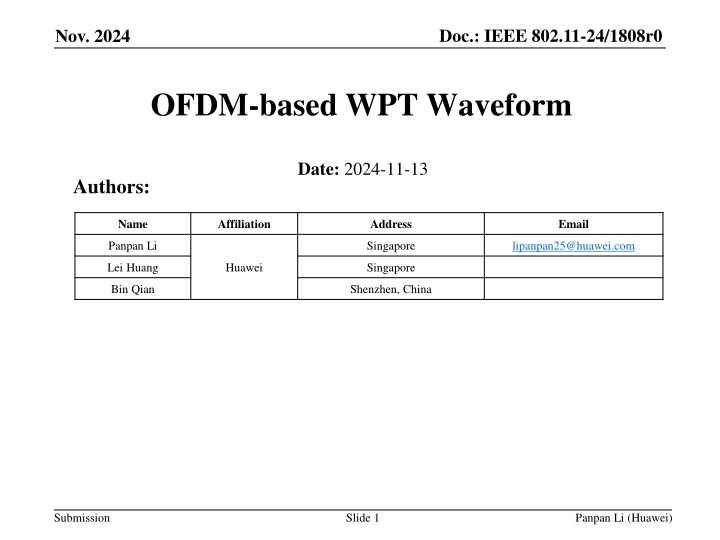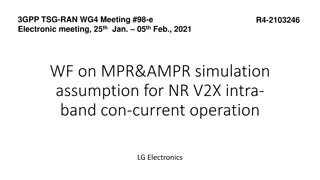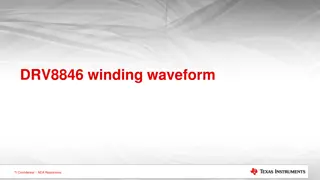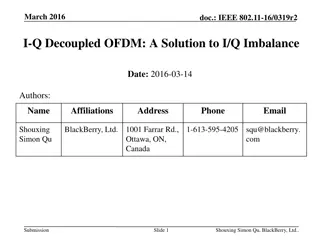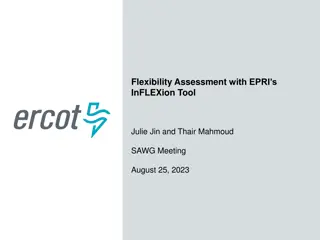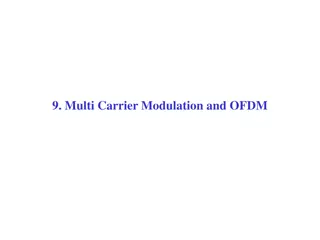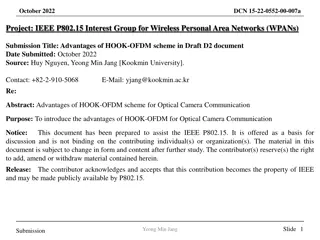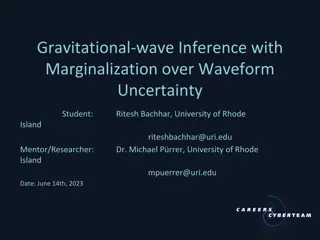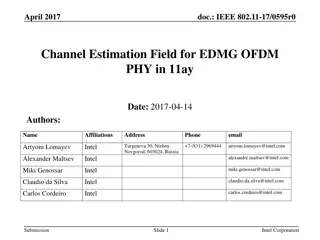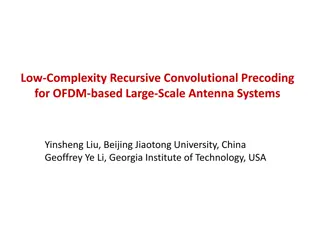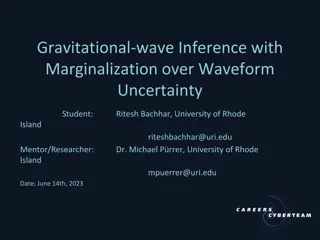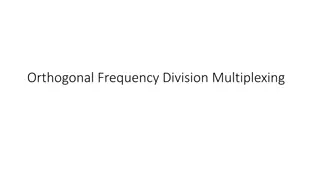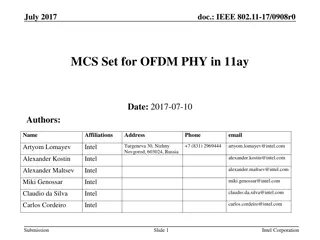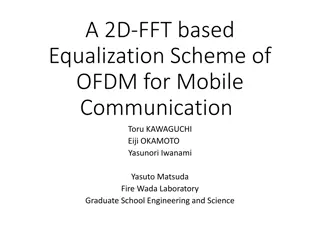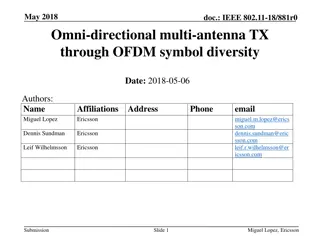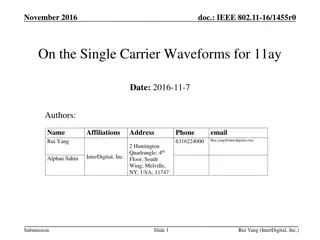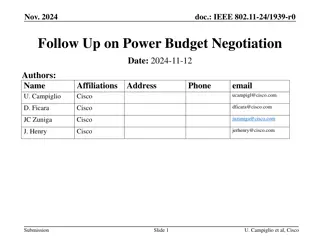OFDM-based WPT Waveform Benefits and Flexibility
This contribution discusses the benefits of OFDM-based WPT waveform in wireless power transfer, focusing on RF-to-DC conversion efficiency and compliance with different regulations. The waveform's features like high PAPR for efficiency and flexibility in adapting to various bandwidth requirements are explored, along with considerations for peak-to-average power ratio impact on RF-to-DC conversion efficiency.
Download Presentation

Please find below an Image/Link to download the presentation.
The content on the website is provided AS IS for your information and personal use only. It may not be sold, licensed, or shared on other websites without obtaining consent from the author.If you encounter any issues during the download, it is possible that the publisher has removed the file from their server.
You are allowed to download the files provided on this website for personal or commercial use, subject to the condition that they are used lawfully. All files are the property of their respective owners.
The content on the website is provided AS IS for your information and personal use only. It may not be sold, licensed, or shared on other websites without obtaining consent from the author.
E N D
Presentation Transcript
Doc.: IEEE 802.11-24/1808r0 Nov. 2024 OFDM-based WPT Waveform Date: 2024-11-13 Authors: Name Affiliation Address Email Panpan Li Singapore lipanpan25@huawei.com Lei Huang Huawei Singapore Bin Qian Shenzhen, China Submission Slide 1 Panpan Li (Huawei)
Doc.: IEEE 802.11-24/1808r0 Nov. 2024 Abstract This contribution intends to discuss the benefits of OFDM-based WPT waveform. Submission Slide 2 Panpan Li (Huawei)
Doc.: IEEE 802.11-24/1808r0 Nov. 2024 Background 11bp PAR [1]: at least one mode of wireless power transfer in the sub-1 GHz (S1G) band is defined to support RF energy harvesting WPT regulation: [2] and [3] presented regional S1G and RFID regulations which may be used for WPT. WPT MAC: WPT protocols and power-related status report/negotiation are discussed in [4-9]. WPT PHY: [10] discussed WPT coexistence issues and presented WPT PPDU including preamble and charging part. [11] started WPT waveform discussion and pointed out the potential of OFDM/DSSS- based WPT waveform, which can be generated by current Wi-Fi systems. Considering various regional regulations and energy-limited use cases, WPT waveform with high efficiency should be designed/recommended. Submission Slide 3 Panpan Li (Huawei)
Doc.: IEEE 802.11-24/1808r0 Nov. 2024 OFDM-based WPT Waveform (1/2) May achieve high PAPR, thus increasing RF-to-DC conversion efficiency Various papers [12,13] show that waveforms with high peak to average power ratio (PAPR) increase RF-to-DC conversion efficiency of the rectifiers. However, too high PAPR also brings problems, such as spectrum expansion; and given the same PA maximizing PAPR will decrease transmitted power to maintain linearity (backoff is needed), and hence will degrade RF to DC efficiency. Instantaneous power of single carrier signal and OFDM signal [12] Submission Slide 4 Panpan Li (Huawei)
Doc.: IEEE 802.11-24/1808r0 Nov. 2024 OFDM-based WPT Waveform (2/2) May flexibly satisfy different regulations Can utilize bandwidth flexibly by adjusting number of subcarriers with non-zero coefficients For example, for wider bandwidth and relaxed TX mask, may use more subcarriers with non-zero coefficients; for narrower bandwidth and strict TX mask, may use less subcarriers with non-zero coefficients. Use less subcarriers, China RFID regulation transmit mask [14] Use more subcarriers, US S1G regulation transmit mask [15] Submission Slide 5 Panpan Li (Huawei)
Doc.: IEEE 802.11-24/1808r0 Nov. 2024 Why not use existing PPDUs as AMP WPT PPDU Theoretically any PPDU in S1G can be used for AMP WPT, but existing PPDUs may have problems and developing new AMP WPT PPDU brings benefits. Problems adopting 11ah PPDU for AMP WPT: China has only RFID spectrum in S1G and doesn t support 11ah channelization. Benefits developing new AMP WPT PPDU: AMP WPT PPDU may have specific preamble, for potential coexistence and power management. If other devices identify an AMP WPT PPDU, it may postpone sending other PPDUs. Submission Slide 6 Panpan Li (Huawei)
Doc.: IEEE 802.11-24/1808r0 Nov. 2024 Summary This contribution discusses the benefits of OFDM-based WPT waveform May achieve high PAPR, thus increasing RF-to-DC conversion efficiency May flexibly satisfy different regulations Submission Slide 7 Panpan Li (Huawei)
Doc.: IEEE 802.11-24/1808r0 Nov. 2024 Reference [1] 11-24-0575-01-0amp-p802-11bp-par. [2] 11-24-0835-00-00bp-overview-of-s1g-and-rfid-spectrum. [3] 11-24-0900-00-00bp-wireless-power-transfer-and-frequency-regulation. [4] 11-24-1208-00-00bp-thoughts-on-the-amp-wpt-protocol. [5] 11-24-1524-02-00bp-follow-up-on-the-amp-wpt-protocol. [6] 11-24-1381-00-00bp-amp-device-power-status. [7] 11-24-1520-00-00bp-charging-and-discharging-intervals-in-passive-amp-stas. [8] 11-24-1539-00-00bp-energy-level-status-reporting-for-amp-devices. [9] 11-24-1561-02-00bp-amp-power-budget-negotiation. [10] 11-24-1536-00-00bp-wireless-power-transfer-for-amp. [11] 11-24-1551-01-00bp-wpt-waveform-discussion. [12] Collado, Ana, and Apostolos Georgiadis. "Optimal waveforms for efficient wireless power transmission." IEEE microwave and wireless components letters 24.5 (2014): 354-356. [13] B. Clerckx and E. Bayguzina, "Waveform Design for Wireless Power Transfer," in IEEE Transactions on Signal Processing, vol. 64, no. 23, pp. 6313-6328, 1 Dec.1, 2016. [14] 800/900MHz RFID . [15] https://www.law.cornell.edu/cfr/text/47/15.247. Submission Slide 8 Panpan Li (Huawei)
Doc.: IEEE 802.11-24/1808r0 Nov. 2024 SP Do you agree to add following content to sub-clause 4 of SFD: IEEE 802.11bp shall specify OFDM-based WPT PPDU format in sub-1 GHz. The detailed WPT PPDU format is TBD. Yes No Abstain Submission Slide 9 Panpan Li (Huawei)
Doc.: IEEE 802.11-24/1808r0 Nov. 2024 Appendix 1: 11ah Operating Class Submission Slide 10 Panpan Li (Huawei)
Doc.: IEEE 802.11-24/1808r0 Nov. 2024 Appendix 2: 11ah max TX Power Submission Slide 11 Panpan Li (Huawei)
Doc.: IEEE 802.11-24/1808r0 Nov. 2024 Appendix 3: China and US S1G regulation Europe TBD. China [i] US [ii] RFID Frequency hopping spread spectrum Digital modulated systems Bands (MHz) 840-845, 920-925 902-928 Bandwidth 250 kHz TX power 2W (ERP) =35.15 dBm(EIRP)) >=50 channel: 36 dBm (EIRP) <50 channel: 30 dBm (EIRP) 36 dBm (EIRP); <=8 dBm in any 3 kHz Transmit mask Adjacent Channel Power Ratio (ACPR): 40dB (first adjacent channel), 60 dB (second adjacent channel) Channel<250kHz, at least 50 channels; Channel>250kHz, at least 25 channels; Maximum allowed 20dB bandwidth is 500kHz minimum 6 dB bandwidth shall be at least 500 kHz [i] 800/900MHz RFID . [ii] https://www.law.cornell.edu/cfr/text/47/15.247. Submission Slide 12 Panpan Li (Huawei)
